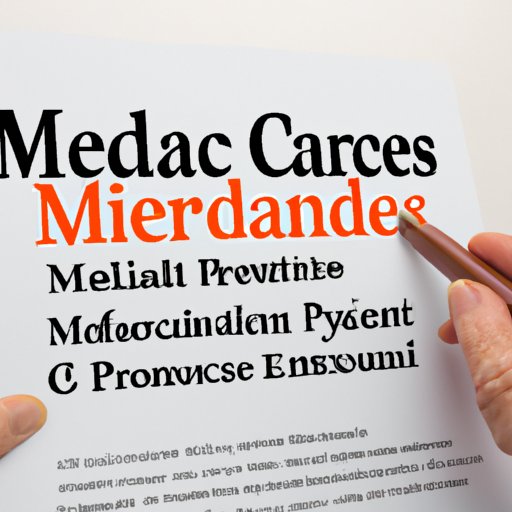Introduction
Medicare is a federal health insurance program administered by the Centers for Medicare & Medicaid Services (CMS). It provides coverage to eligible individuals, including those aged 65 and older and those with certain disabilities.
There are four parts of Medicare: Part A, Part B, Part C, and Part D. Each part covers different services, costs, and eligibility requirements. In this article, we will explore the benefits and costs associated with each part, as well as how to enroll in Medicare.

Exploring the Benefits and Costs of Medicare
Part A of Medicare covers hospital care, skilled nursing facility care, hospice care, and home health care. It is generally free for those who have worked and paid into the Social Security system for at least 10 years, but some may be required to pay a premium depending on their work history. According to the CMS, “For 2021, most people don’t pay a monthly premium for Part A (sometimes called ‘premium-free Part A’).”
Part B of Medicare covers doctor visits, preventive care, outpatient care, mental health services, and durable medical equipment. Most beneficiaries are required to pay a monthly premium for Part B, which is determined by their income. For 2021, the standard Part B premium is $148.50 per month.
Part C of Medicare, also known as Medicare Advantage, is an alternative to Original Medicare. It is offered by private insurance companies approved by Medicare. These plans typically include all the benefits of Parts A and B, as well as additional coverage such as vision, hearing, dental, and prescription drug coverage. The cost of these plans vary depending on the provider, plan type, and location.
Part D of Medicare covers prescription drugs. This coverage is provided through private insurance companies approved by Medicare. Beneficiaries can choose from a variety of plans with varying premiums, deductibles, and copayments. The cost of Part D plans also varies based on the provider, plan type, and location.
In addition to the monthly premiums for Parts B and D, Medicare beneficiaries may also be responsible for deductibles, coinsurance, and copayments. Beneficiaries should also be aware of the coverage gaps that exist with Original Medicare.
How to Enroll in Medicare
Individuals who are eligible for Medicare can enroll in the program three months before they turn 65, during their birth month, or three months after their birth month. There are several ways to enroll, including online, by phone, or in person.
To be eligible for Medicare, individuals must be either 65 years of age or older, or have a disability or end-stage renal disease. Individuals who are receiving Social Security or Railroad Retirement Board benefits will automatically be enrolled in Medicare Part A and Part B.
Navigating Medicare for Seniors
Seniors may be eligible for extra help with their Medicare expenses. The Extra Help program helps pay for the costs associated with Medicare Part D, such as premiums, deductibles, and co-insurance. To be eligible for Extra Help, individuals must meet certain income and resource limits.
Seniors may also be able to get assistance with other aspects of Medicare, such as understanding coverage options, filing appeals, and finding resources to help pay for healthcare costs. Organizations like the Medicare Rights Center provide free counseling and advocacy services to help seniors navigate the Medicare system.
Medicare for Disabled Individuals
Disabled individuals may be eligible for Medicare if they are under the age of 65 and have been receiving Social Security Disability Insurance (SSDI) benefits for 24 months or more. Individuals who have been diagnosed with end-stage renal disease or amyotrophic lateral sclerosis (ALS) may also be eligible for Medicare.
The enrollment process for disabled individuals is similar to that for seniors. Individuals must meet certain eligibility requirements and apply for Medicare through the Social Security Administration or Railroad Retirement Board.
Conclusion
Medicare is a federal health insurance program that provides coverage for eligible individuals, including seniors and those with disabilities. It offers comprehensive coverage for hospital care, doctor visits, preventive care, and prescription drugs. There are four parts of Medicare, each with its own costs and benefits. Individuals who are eligible for Medicare can enroll online, by phone, or in person.
Seniors may be eligible for extra help with Medicare costs, and there are resources available to help them navigate the Medicare system. Disabled individuals who are eligible for Medicare can apply through the Social Security Administration or Railroad Retirement Board.
Overall, Medicare is a valuable resource for individuals who are eligible for coverage. By understanding the different parts of Medicare and the enrollment process, individuals can make informed decisions about their healthcare needs.
(Note: Is this article not meeting your expectations? Do you have knowledge or insights to share? Unlock new opportunities and expand your reach by joining our authors team. Click Registration to join us and share your expertise with our readers.)
